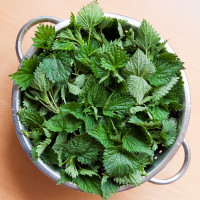The Trees
poetry by Philip Larkin
The trees are coming into leaf
Like something almost being said;
The recent buds relax and spread
Their greenness is a kind of grief.
Is it that they are born again
And we grow old? No, they die too,
Their yearly trick of looking new
Is written down in rings of grain.
Yet still the unresting castles thresh
In fullgrown thickness every May.
Last year is dead, they seem to say,
Begin afresh, afresh, afresh.
Indigestion
Never has our digestive system’s ability to function been so messed up. Before refrigeration, foodborne illnesses were intense and dangerous, but now abdominal pain, heartburn, bloating, diarrhea, constipation, and nausea seem the norm rather than the result of disease. Infections, still prevalent despite sanitation improvement, coupled with our environment and stressful lifestyles create a digestion nightmare. This trouble is not a dream, though. From food allergies and sensitivities to microbial imbalances to elimination problems like diarrhea and constipation to bloating, gas, and heartburn to difficulty in maintaining a healthy weight to chronic diseases like cancer and diabetes, the list goes on and on. The odds stack up against our ability to healthfully assimilate the foods we eat to the energy we need. Stress, toxins, allergens, nutritional deficiencies negatively pile the scales to the left. Hope lies in the balance on the other side and plants are leading players.
Healing paths look to food as medicine. Science and research support maintaining a healthy microbiome, the newly discovered organ that comprises the millions of bacteria living within us, but we are only just beginning to understand it all. The road is confusing with obstacles, unknowns and misdirection, but the resounding theme to success speaks purity. The chemicals used to farm food and in processed food pose as the villains with the sustainable, organic, non-GMO food movements as heroes. It is all about choice and we have the power to choose healthfully. The green leaves of herbal medicines as part of a whole food, organic, plant-based way of eating appear like superpowers, limited only by their scarcity of use. The challenge lies in finding ways to incorporate herbal greens as many ways as possible into our daily life pushing aside the bad actors.
This is a huge topic. In the journey to reclaiming control over healthy digestion, turning over a new leaf in spring takes on literal meaning. As the leaves begin to bud outside, two important plant leaf benefits start us on a trail guided by our senses.
With sight, we witness chlorophyll in every green leaf. Plants require it for survival. Chlorophyll provides building blocks for strengthening blood, immunity, hormonal balance, and bones. As an antioxidant and anti-inflammatory, chlorophyll supports maintenance of healthy tissues and body functions. Most profoundly, chlorophyll acts to aid detoxification by binding toxic compounds during digestion. As environmental and lifestyle toxins make their way through our bodies, we rely most on the detoxification processes in our liver for conversion to non-damaging compounds that can be eliminated safely. This detoxification pathway works overtime with chlorophyll supporting its function. Specifically, chlorophyll’s antioxidant power terminates reactions that damage our cells. It binds to carcinogenic compounds preventing them from attaching to and altering our healthy structural and functional cells. As such, chlorophyll has been shown to decrease risk of liver, skin, esophageal and stomach cancers.
Understanding how chlorophyll works in plants makes for easier appreciation for its use to humans. Again we measure a plant’s chlorophyll intensity with our eyes in degrees of greenness. Its electric company role absorbs the sun’s light energy then converts it to a form used in photosynthesis to nourish the plant. Chlorophyll stored in plant leaves becomes available as a nutrient rich, antioxidant, immune building food every time we consume them.
With taste, we experience leaf bitter, a flavor that often yields a negative reaction. Of course, taste preferences are individual. For me, even though bitter on the tongue may cause an initial shutter, once inside it feels good. Merely the taste of a bitter herb initiates digestive action. When bitter taste receptors are stimulated they ignite a surge of digestive enzymes. They transform digestion by increasing enzymatic secretions, whether saliva, stomach juices, or pancreatic enzymes. All of this moistens food allowing for better movement through the digestive tract, breaking it down into substances that facilitate optimal nutrient absorption. Additionally, most bitters simulate the liver and release of bile from the gallbladder vital to fat digestion and stool production. Apart from the ability to stimulate digestive processes, bitters are also known for their affect on appetite and control of sweet cravings.
With bitters, more is not always better. A bite of a green leaf or a drop or two of a bitters formula tincture is all that is needed to help constipation, gas, slow digestion, abdominal cramping, and stimulation of appetite. John Scudder, an early 20th century Eclectic Physician said it best…it is not possible to point out any better evidence of the need for bitter tonics than impaired appetite, digestion, and nutrition.
With each leaf rustling in wind, our ears can hear the calling to eat more greens for their powerful nutritional impact. Plant greens support digestion in this way as well, providing those nutrients that are often deficient, yet vital to chemical digestive processes. Vitamins A, C, E and K, minerals such as magnesium, iron, potassium, calcium, and antioxidants like essential fatty acids and beta-carotene are abundant in greens. While March is not yet an outside green month, thoughts turn to fresh fruits, vegetables and farmer’s markets for the internal fresh start and renewal that comes with the signs of spring.
Nutrient-Rich Herbal Leaves
- Alfalfa
- Basil
- Burdock
- Carrot leaves
- Chickweed
- Cilantro
- Cleavers
- Dandelion
- Horsetail
- Kelp
- Lamb’s quarter
- Marshmallow
- Mullein
- Nettles
- Oat straw
- Parsley
- Plantain
- Raspberry leaf
- Shepard’s purse
- Watercress
- Yellow dock
Plant Profile

Nettles
References
http://www.poetryarchive.org/poem/trees
http://www.naturodoc.com/library/nutrition/herbvit.htm
http://www.iffgd.org/site/gi-disorders/